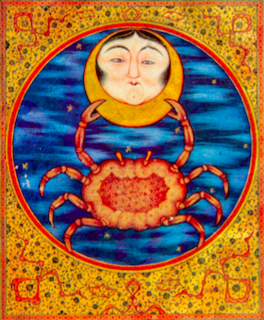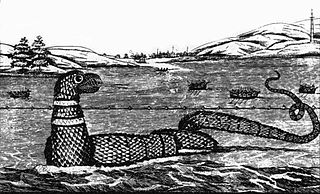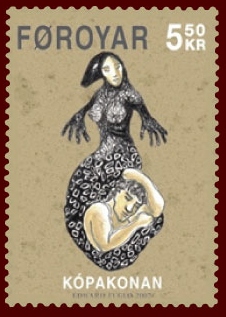 W
WThe ahuizotl is a legendary creature in Aztec mythology. It is said to lure people to their deaths. The creature was taken as a mascot by the ruler of the same name, and was said to be a "friend of the rain gods".
 W
WApkallu (Akkadian) and Abgal (Sumerian) are terms found in cuneiform inscriptions that in general mean either "wise" or "sage".
 W
WThe Bakunawa is a serpent-like dragon in Philippine mythology. It is believed to be the cause of eclipses, earthquakes, rains, and wind. The movements of the Bakunawa served as a geomantic calendar system for ancient Filipinos and were part of the shamanistic rituals of the babaylan. It is usually depicted with a characteristic looped tail and a single horn on the nose. It was generally believed to be a sea serpent, but are also variously believed to inhabit either the sky or the underworld.
 W
WThe boobrie is a mythological shapeshifting entity inhabiting the lochs of the west coast of Scotland. It commonly adopts the appearance of a gigantic water bird resembling a cormorant or great northern diver, but it can also materialise in the form of various other mythological creatures such as a water bull.
 W
WCancer (♋︎) is the fourth astrological sign in the Zodiac, originating from the constellation of Cancer. It spans from 90° to 120° celestial longitude. Under the tropical zodiac, the Sun transits this area between approximately June 22 and July 22, and under the sidereal zodiac, the Sun transits this area between approximately July 21 and August 9.
 W
WIn Ancient Greek kētŏs, Latinized as cetus, is any huge sea creature or sea monster. According to the mythology Perseus slew Cetus to save Andromeda from being sacrificed to it. In a different story, Heracles slew Cetus to save Hesione. The term cetacean derives from cetus. In Greek art, ceti were depicted as serpentine fish. The name of the mythological figure Ceto is derived from kētos. The name of the constellation Cetus also derives from this word.
 W
WCoi Coi-Vilu or Caicai-Vilu is the Mapuche god of water and, according to Mapuche myths, supreme ruler of the sea and of all sea-dwellers. This snake was a central figure in the Origin Of The Chiloean Archipelago. In Mapuche mythology, Coi Coi-Vilu is son of Peripillan.
 W
WIn late Classical Greek art, ichthyocentaurs were centaurine sea beings with the upper body of a human, the lower anterior half and fore-legs of a horse, and the tailed half of a fish. The earliest example dates to the 2nd century B. C., among the friezes in the Pergamon Altar. There are further examples of Aphros and/or Bythos, the personifications of foam and abyss, respectively, depicted as ichthyocentaurs in mosaics and sculptures.
 W
WLotan is a servant of the sea god Yam defeated by the storm god Hadad-Baʿal in the Ugaritic Baal Cycle. possibly with the help or by the hand of his sister ʿAnat. Lotan seems to have been prefigured by the serpent Têmtum represented in Syrian seals of the 18th–16th century BC, and finds a later reflex in the sea monster Leviathan, whose defeat at the hands of Yahweh is alluded to in the biblical Book of Job and in Isaiah 27:1. Lambert (2003) went as far as the claim that Isaiah 27:1 is a direct quote lifted from the Ugaritic text, correctly rendering Ugaritic bṯn "snake" as Hebrew nḥš "snake".
 W
WLyngbakr is the name of a massive whale-like sea monster reported in the Örvar-Odds saga to have existed in the Greenland Sea. According to the saga, Lyngbakr would bait seafarers by posing as a heather-covered island, and when a crew landed on his back, he sank into the sea, drowning the crew.
 W
WMakara is a legendary sea-creature in Hindu mythology. In Hindu astrology, Makara is equivalent to the Zodiac sign Capricorn.
 W
WThe Gloucester sea serpent is a creature reportedly seen around and off the coast of Gloucester, Massachusetts and Cape Ann area. The heyday of sightings began in August 1817 and continued into 1818–19. The earliest alleged sighting of such a creature off Cape Ann was recorded in 1638 by John Josselyn. Occasional sightings continued over the centuries and into the 20th century.
 W
WThe kraken is a legendary cephalopod-like sea monster of gigantic size in Scandinavian folklore. According to the Norse sagas, the kraken dwells off the coasts of Norway and Greenland and terrorizes nearby sailors. Authors over the years have postulated that the legend may have originated from sightings of giant squids that may grow to 13–15 meters in length. The sheer size and fearsome appearance attributed to the kraken have made it a common ocean-dwelling monster in various fictional works. The kraken has been the focus of many superstitious sailors passing the North Atlantic and especially sailors from the Nordic countries due to their proximity and its Scandinavian origin. Throughout the centuries the kraken has been a staple part of sailors' superstitions and mythos being heavily linked to sailors' ability of telling a tall tale.
 W
WSea monsters are beings from folklore believed to dwell in the sea and often imagined to be of immense size. Marine monsters can take many forms, including sea dragons, sea serpents, or multi-armed beasts. They can be slimy and scaly and are often pictured threatening ships or spouting jets of water. The definition of a "monster" is subjective; further, some sea monsters may have been based on scientifically accepted creatures, such as whales and types of giant and colossal squid.
 W
WThe Mugwump is a lake monster which has been alleged to live in Lake Timiskaming, on the border of the Canadian provinces of Ontario and Quebec.
 W
WIn Canadian folklore, the Ogopogo or Oggy is a lake monster said to inhabit Okanagan Lake in British Columbia, Canada. Some scholars have charted the entity's development from First Nations folklore and widespread water monster folklore motifs. The Ogopogo now plays a role in the commercial symbolism and media representation of the region.
 W
WA sea goat is a legendary aquatic animal described as a creature that is half goat and half fish.
 W
WThe sea monk was a sea creature found off the eastern coast of the Danish island of Zealand in 1546. It was described as a "fish" that outwardly resembled a human monk in his habit. A 2005 paper concluded that the animal was most likely an angelshark.
 W
WIn Scottish mythology, selkies or selkie folk meaning "seal folk" are mythological beings capable of therianthropy, changing from seal to human form by shedding their skin. They are found in folktales and mythology originating from the Northern Isles of Scotland.
 W
WUmi zatō (海座頭) is a Japanese yōkai that in the Gazu Hyakki Yagyō by Toriyama Sekien and in various emakimono such as the Matsui Library's Hyakki Yagyō Emaki.
 W
WUmibōzu is a paranormal phenomena or yōkai from Japanese folklore. Other names include Umihōshi or Uminyūdō . Little is known of the origin of umibōzu but it is a sea-spirit and as such has multiple sightings throughout Japan. Normally, umibōzu appears to sailors on calm seas which quickly turn tumultuous. It either breaks the ship on emergence or demands a bucket or barrel from the sailors and proceeds to drown them. The only safe way to escape an umibōzu is to give it a bottomless barrel and sail away while it is confused.